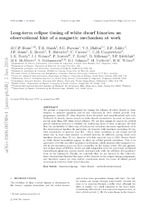| dc.description.abstract | We present a long-term programme for timing the eclipses of white dwarfs in close binaries to measure apparent and/or real variations in their orbital periods. Our programme includes 67 close binaries, both detached and semi-detached and with M-dwarfs, K-dwarfs, brown dwarfs or white dwarfs secondaries. In total, we have observed more than 650 white dwarf eclipses. We use this sample to search for orbital period variations and aim to identify the underlying cause of these variations. We find that the probability of observing orbital period variations increases significantly with the observational baseline. In particular, all binaries with baselines exceeding 10 yrs, with secondaries of spectral type K2 -- M5.5, show variations in the eclipse arrival times that in most cases amount to several minutes. In addition, among those with baselines shorter than 10 yrs, binaries with late spectral type (>M6), brown dwarf or white dwarf secondaries appear to show no orbital period variations. This is in agreement with the so-called Applegate mechanism, which proposes that magnetic cycles in the secondary stars can drive variability in the binary orbits. We also present new eclipse times of NN Ser, which are still compatible with the previously published circumbinary planetary system model, although only with the addition of a quadratic term to the ephemeris. Finally, we conclude that we are limited by the relatively short observational baseline for many of the binaries in the eclipse timing programme, and therefore cannot yet draw robust conclusions about the cause of orbital period variations in evolved, white dwarf binaries. | en_US |

